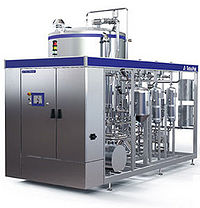Difference between revisions of "Line Blenders"
(Created page with "Category:Mixing{{Knoppen}} <noinclude><!------------------------------------------------ * READ THIS FIRST * Only edit this page if you can improve the content. * Improper u...") |
PurplePen19 (talk | contribs) |
||
| Line 7: | Line 7: | ||
* Please start editing this page after the /noinclude | * Please start editing this page after the /noinclude | ||
* -------------------------------------------------></noinclude> | * -------------------------------------------------></noinclude> | ||
[[File:Line Blenders.jpg|thumb|200px|right|Line Blenders]] | |||
'''Line Blenders''', sometimes called "in line mixers", provide mixing action inside a pipe. Line Blenders are typically used for premix or fast reaction applications and a variety of blending applications in chemical processing, food processing, petroleum refining, pulp & paper processing and waste water treatment. | |||
==Common Features== | |||
Supplied complete with motor and impeller(s) | |||
Excellent for continuous process applications | |||
Provide almost instantaneous mixing | |||
More space-efficient than conventional tank/mixer systems | |||
Economical to operate and maintain | |||
==Principles of Operations== | |||
The line blender includes a conduit having a hollow interior disposed about a central axis and a shaft extending longitudinally through the conduit along the central axis. The blender also includes a plurality of stationary mixing stages extending in series along the central axis with each of the mixing stages defining a plurality of spiral channels within the hollow interior of the conduit. Each of the mixing stages includes a plurality of distinct segments extending in series along the central axis. The blender further includes means for adjusting both the angular and the axial position of each of the segments with respect to adjacent segments along the shaft. The in-line blender is assembled by securing a retaining device to one end of the shaft, placing a plurality of mixing elements on the shaft in sliding engagement therewith, and positioning each mixing element at a desired angular and axial position on the shaft. A holding device is secured on a second end of the shaft so as to hold the mixing element in compression between the holding device and the retaining device. The shaft and mixing elements are then placed within a conduit and secured therein so as to prevent relative axial movement there between. | |||
==Video== | |||
<youtube>PP4lPpt-eOI</youtube> | |||
Latest revision as of 02:14, 31 August 2012
Line Blenders, sometimes called "in line mixers", provide mixing action inside a pipe. Line Blenders are typically used for premix or fast reaction applications and a variety of blending applications in chemical processing, food processing, petroleum refining, pulp & paper processing and waste water treatment.
Common Features
Supplied complete with motor and impeller(s) Excellent for continuous process applications Provide almost instantaneous mixing More space-efficient than conventional tank/mixer systems Economical to operate and maintain
Principles of Operations
The line blender includes a conduit having a hollow interior disposed about a central axis and a shaft extending longitudinally through the conduit along the central axis. The blender also includes a plurality of stationary mixing stages extending in series along the central axis with each of the mixing stages defining a plurality of spiral channels within the hollow interior of the conduit. Each of the mixing stages includes a plurality of distinct segments extending in series along the central axis. The blender further includes means for adjusting both the angular and the axial position of each of the segments with respect to adjacent segments along the shaft. The in-line blender is assembled by securing a retaining device to one end of the shaft, placing a plurality of mixing elements on the shaft in sliding engagement therewith, and positioning each mixing element at a desired angular and axial position on the shaft. A holding device is secured on a second end of the shaft so as to hold the mixing element in compression between the holding device and the retaining device. The shaft and mixing elements are then placed within a conduit and secured therein so as to prevent relative axial movement there between.
Video
